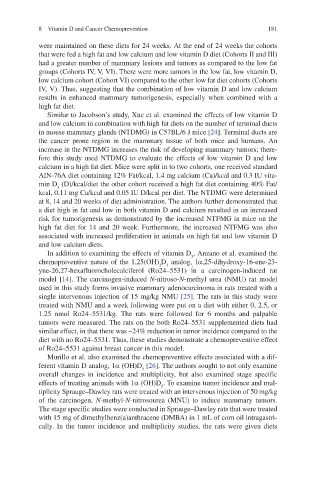Page 194 - Vitamin D and Cancer
P. 194
8 Vitamin D and Cancer Chemoprevention 181
were maintained on these diets for 24 weeks. At the end of 24 weeks the cohorts
that were fed a high fat and low calcium and low vitamin D diet (Cohorts II and III)
had a greater number of mammary lesions and tumors as compared to the low fat
groups (Cohorts IV, V, VI). There were more tumors in the low fat, low vitamin D,
low calcium cohort (Cohort VI) compared to the other low fat diet cohorts (Cohorts
IV, V). Thus, suggesting that the combination of low vitamin D and low calcium
results in enhanced mammary tumorigenesis, especially when combined with a
high fat diet.
Similar to Jacobson’s study, Xue et al. examined the effects of low vitamin D
and low calcium in combination with high fat diets on the number of terminal ducts
in mouse mammary glands (NTDMG) in C57BL/6 J mice [24]. Terminal ducts are
the cancer prone region in the mammary tissue of both mice and humans. An
increase in the NTDMG increases the risk of developing mammary tumors; there-
fore this study used NTDMG to evaluate the effects of low vitamin D and low
calcium in a high fat diet. Mice were split in to two cohorts, one received standard
AIN-76A diet containing 12% Fat/kcal, 1.4 mg calcium (Ca)/kcal and 0.3 IU vita-
min D (D)/kcal/diet the other cohort received a high fat diet containing 40% Fat/
3
kcal, 0.11 mg Ca/kcal and 0.05 IU D/kcal per diet. The NTDMG were determined
at 8, 14 and 20 weeks of diet administration. The authors further demonstrated that
a diet high in fat and low in both vitamin D and calcium resulted in an increased
risk for tumorigenesis as demonstrated by the increased NTFMG in mice on the
high fat diet for 14 and 20 week. Furthermore, the increased NTFMG was also
associated with increased proliferation in animals on high fat and low vitamin D
and low calcium diets.
In addition to examining the effects of vitamin D , Anzano et al. examined the
3
chemopreventive nature of the 1,25(OH) D analog, la,25-dihydroxy-16-ene-23-
2 3 ,
yne-26,27-hexafluorocholecalciferol (Ro24–5531) in a carcinogen-induced rat
model [14]. The carcinogen-induced N-nitroso-N-methyl urea (NMU) rat model
used in this study forms invasive mammary adenocarcinoma in rats treated with a
single intervenous injection of 15 mg/kg NMU [25]. The rats in this study were
treated with NMU and a week following were put on a diet with either 0, 2.5, or
1.25 nmol Ro24–5531/kg. The rats were followed for 6 months and palpable
tumors were measured. The rats on the both Ro24–5531 supplemented diets had
similar effect, in that there was ~24% reduction in tumor incidence compared to the
diet with no Ro24–5531. Thus, these studies demonstrate a chemopreventive effect
of Ro24–5531 against breast cancer in this model.
Murillo et al. also examined the chemopreventive effects associated with a dif-
ferent vitamin D analog, 1a (OH)D [26]. The authors sought to not only examine
5
overall changes in incidence and multiplicity, but also examined stage specific
effects of treating animals with 1a (OH)D . To examine tumor incidence and mul-
5
tiplicity Sprauge–Dawley rats were treated with an intervenous injection of 50 mg/kg
of the carcinogen, N-methyl-N-nitrosourea (MNU) to induce mammary tumors.
The stage specific studies were conducted in Sprauge–Dawley rats that were treated
with 15 mg of dimethylbenz(a)anthracene (DMBA) in 1 mL of corn oil intragastri-
cally. In the tumor incidence and multiplicity studies, the rats were given diets

